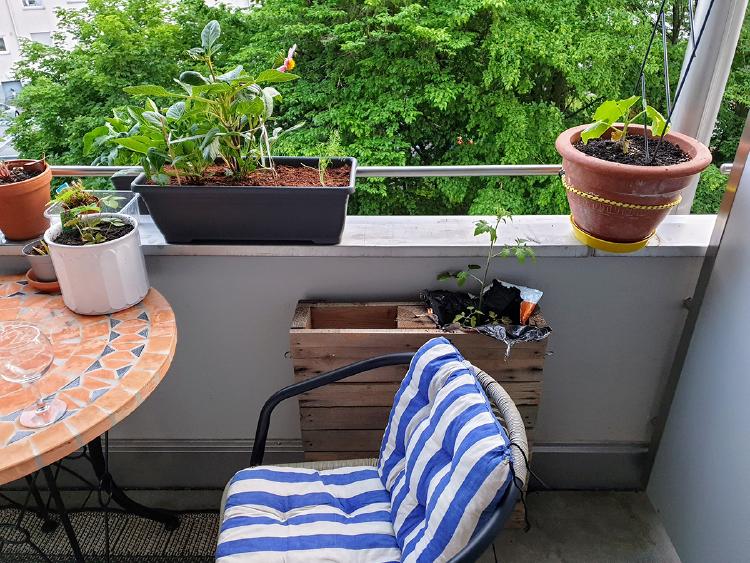June Update
This is the craziest time of the year for gardeners. Everything is growing so fast that we can’t keep up. For a while I managed to keep on top of everything but now I’m falling behind, in both the Kleingarten and my Balkongarten. The most pressing jobs in the Kleingarten, such as the grapevine roof trellis and winter rye cutting, are completed on time, but the balcony has taken a back seat. This past weekend I committed myself to the balcony, which is finally taking shape, although there’s still a lot that needs to be done.

Some of the chaos on the balcony
My main task was to get plants into their final pots. Two tomato plants, dahlias, wallflowers, a cucumber, and pepper seedlings were all desperate for transplanting. All but one tomato plant made it into new pots. Unfortunately, it has to wait until I can get more soil, which adds to the delays.

One tomato plant planted in the pallet container
Between the two tomato plants, I planted the worse-looking one. I was afraid that if I didn’t I would lose it. But on this seed-to-plant journey I’ve noticed a difference in stress and plant growth based on what type of pot they were grown in. The weaker tomato plant was in a peat pot and significantly shorter than the other in a plastic pot. The plastic pot tomato is taller, has dark green leaves and, even more surprising, has not one but two plants inside. Having multiple plants in a pot like this normally stunts their growth. I find it very interesting that the two tomatoes are doing better than the one alone in a peat pot the same size. This also conflicts with my desire to reduce plastic in the garden.
Both plants were doing equally well up to a certain point— the point when they needed to be planted out two weeks ago. It appears that biodegradable pots are great but you need to keep on top of schedule and plant out the plants the moment they are ready. Plastic pots may allow for a flexible time frame, keeping the plants happy awhile longer until you’re able to transplant them out.
At the moment, the plastic pot tomatoes are just now showing signs that they are desperate to get into their final place. Their lower leaves turning lime green/yellow, and they are beginning to produce flowers even though they are not yet at their mature height: since they are annuals, their goal is to grow, reproduce, and then die. These particular plants assume they need to reproduce sooner because of the poor conditions. From their viewpoint, producing a few fruits is better than producing none. So my plan of growing two meter tall plants, for both some shade on the balcony and a bountiful harvest, may be lost if they don’t get planted soon.
Keeping to the theme of biodegradable pots, I have mixed feelings about the newspaper pots I used to start seedlings. They are great but, again, only if you keep on top of the plant care, otherwise they turn into a nightmare. The pots dry out faster so they require constant attention to the moisture levels. They also dry out unevenly, with pots on the outside drying faster than those in the middle. And once the true leaves appear twice the size as the seed leaves, they require immediate potting on into a nutrient-rich soil.

Newspaper pots in April
I still need to do a few more tests, but my current advice for biodegradable pots is to stick to the plant’s schedule, not yours. As soon as you see these signals, you have to act quickly no matter how busy your life is, otherwise they’ll end up stunted or die. Pay attention to what your plants are telling you and they will reward you in kind.
- Filed to:
- balkongarten
- thoughts


